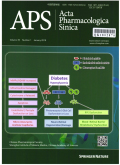- 钛学术文献服务平台 \
- 学术期刊 \
- 医药卫生期刊 \
- 药学期刊 \
- 中国药理学报(英文版)期刊 \
null
Chinese herbal formula Fuzheng Huayu alleviates CCI4-induced liver fibrosis in rats: a transcriptomic and proteomic analysis
基本信息来源于合作网站,原文需代理用户跳转至来源网站获取
摘要:
Liver fibrosis is a consequence of chronic liver disease that can progress to liver cirrhosis or even hepatocarcinoma. Fuzheng Huayu (FZHY), a Chinese herbal formula, has been shown to exert anti-fibrotic effects. To better understand the molecular mechanisms underlying the anti-fibrotic effects of FZHY, we analyzed transcriptomic and proteomic combination profiles in CCI4-induced liver fibrosis in rats, which were treated with extracted FZHY powder (0.35 g.kg-1-d-1, ig) for 3 weeks. We showed that FZHY administration significantly improved liver function, alleviated hepatic inflammatory and fibrotic changes, and decreased the hydroxyproline content in the livers of CCI4-treated rats. When their liver tissues were examined using microarray and iTRAQ, we found 255 differentially expressed genes (fold change >1.5, P<0.05) and 499 differentially expressed proteins (fold change >1.2, P<0.05) in the FZHY and model groups. Functional annotation with DAVID (The Database for Annotation, Visualization and Integrated Discovery) showed that 15 enriched gene ontology terms, including drug metabolic process, response to extracellular stimulus, response to vitamins, arachidonic acid metabolic process, response to wounding, and oxidation reduction might be involved in the anti-fibrotic effects of FZHY; whereas KEGG pathway analysis revealed that eight enriched pathways, including arachidonic acid metabolism, retinol metabolism, metabolism of xenobiotics by cytochrome P450, and drug metabolism might also be involved. Moreover, the protein-protein interaction network demonstrated that 10 core genes/proteins overlapped, with Ugt2a3, Cyp2b1 and Cyp3a18 in retinol metabolism pathway overlapped to a higher degree. Compared to the model rats, the livers of FZHY-treated rats had significantly higher mRNA and protein expression levels of Ugt2a3, Cyp2b1 and Cyp3a18. Furthermore, the concentration of retinoic acid was significantly higher in the FZHY-treated rats compared with the model rats. The results suggest that the anti-fibrotic effects of FZHY emerge through multiple targets, multiple functions, and multiple pathways, including FZHY-regulated retinol metabolism, xenobiotic metabolism by cytochrome P450, and drug metabolism through up-regulated Ugt2a3, Cyp2b1,and Cyp3a18. These genes may play important anti-fibrotic roles in FZHY-treated rats.

推荐文章
期刊_丙丁烷TDLAS测量系统的吸收峰自动检测
带间级联激光器
调谐半导体激光吸收光谱
雾剂检漏 中红外吸收峰 洛伦兹光谱线型
不同盐度、温度及光照对漂浮浒苔生理生态的影响
浒苔
盐度
温度
光照
生理生态
期刊_联合空间信息的改进低秩稀疏矩阵分解的高光谱异常目标检测
高光谱图像
异常目标检测 低秩稀疏矩阵分解 稀疏矩阵 残差矩阵
内容分析
关键词云
关键词热度
相关文献总数
(/次)
(/年)
文献信息
| 篇名 | Chinese herbal formula Fuzheng Huayu alleviates CCI4-induced liver fibrosis in rats: a transcriptomic and proteomic analysis | ||
| 来源期刊 | 中国药理学报(英文版) | 学科 | |
| 关键词 | Chinese herbal formula Fuzheng Huayu CCI4-induced liver fibrosis transcriptomics proteomics | ||
| 年,卷(期) | 2018,(6) | 所属期刊栏目 | |
| 研究方向 | 页码范围 | 930-941 | |
| 页数 | 12页 | 分类号 | |
| 字数 | 语种 | 英文 | |
| DOI | 10.1038/aps.2017.150 | ||
五维指标
引文网络
引文网络
二级参考文献 (467)
共引文献 (163)
参考文献 (50)
节点文献
引证文献 (0)
同被引文献 (0)
二级引证文献 (0)
1981(1)
- 参考文献(0)
- 二级参考文献(1)
1983(1)
- 参考文献(0)
- 二级参考文献(1)
1988(1)
- 参考文献(0)
- 二级参考文献(1)
1992(1)
- 参考文献(0)
- 二级参考文献(1)
1993(2)
- 参考文献(0)
- 二级参考文献(2)
1994(2)
- 参考文献(0)
- 二级参考文献(2)
1995(1)
- 参考文献(0)
- 二级参考文献(1)
1996(10)
- 参考文献(0)
- 二级参考文献(10)
1997(8)
- 参考文献(0)
- 二级参考文献(8)
1998(8)
- 参考文献(1)
- 二级参考文献(7)
1999(5)
- 参考文献(0)
- 二级参考文献(5)
2000(2)
- 参考文献(0)
- 二级参考文献(2)
2001(5)
- 参考文献(0)
- 二级参考文献(5)
2002(5)
- 参考文献(1)
- 二级参考文献(4)
2003(9)
- 参考文献(0)
- 二级参考文献(9)
2004(5)
- 参考文献(0)
- 二级参考文献(5)
2005(7)
- 参考文献(1)
- 二级参考文献(6)
2006(5)
- 参考文献(1)
- 二级参考文献(4)
2007(17)
- 参考文献(1)
- 二级参考文献(16)
2008(12)
- 参考文献(2)
- 二级参考文献(10)
2009(20)
- 参考文献(0)
- 二级参考文献(20)
2010(29)
- 参考文献(2)
- 二级参考文献(27)
2011(43)
- 参考文献(0)
- 二级参考文献(43)
2012(30)
- 参考文献(6)
- 二级参考文献(24)
2013(27)
- 参考文献(3)
- 二级参考文献(24)
2014(34)
- 参考文献(9)
- 二级参考文献(25)
2015(33)
- 参考文献(13)
- 二级参考文献(20)
2016(46)
- 参考文献(3)
- 二级参考文献(43)
2017(49)
- 参考文献(2)
- 二级参考文献(47)
2018(51)
- 参考文献(0)
- 二级参考文献(51)
2019(39)
- 参考文献(0)
- 二级参考文献(39)
2020(9)
- 参考文献(5)
- 二级参考文献(4)
2018(51)
- 参考文献(0)
- 二级参考文献(51)
- 引证文献(0)
- 二级引证文献(0)
研究主题发展历程
节点文献
Chinese herbal formula
Fuzheng Huayu
CCI4-induced liver fibrosis
transcriptomics
proteomics
研究起点
研究来源
研究分支
研究去脉
引文网络交叉学科
相关学者/机构
期刊影响力
中国药理学报(英文版)
主办单位:
中国药理学会和中科院上海药物研究所
出版周期:
月刊
ISSN:
1671-4083
CN:
31-1347/R
开本:
大16开
出版地:
上海市太原路294号
邮发代号:
4-295
创刊时间:
1980
语种:
eng
出版文献量(篇)
4416
总下载数(次)
2
总被引数(次)
42236
期刊文献
相关文献
推荐文献
- 期刊分类
- 期刊(年)
- 期刊(期)
- 期刊推荐
中国药理学报(英文版)2022
中国药理学报(英文版)2021
中国药理学报(英文版)2020
中国药理学报(英文版)2019
中国药理学报(英文版)2018
中国药理学报(英文版)2017
中国药理学报(英文版)2016
中国药理学报(英文版)2015
中国药理学报(英文版)2014
中国药理学报(英文版)2013
中国药理学报(英文版)2012
中国药理学报(英文版)2011
中国药理学报(英文版)2010
中国药理学报(英文版)2009
中国药理学报(英文版)2008
中国药理学报(英文版)2007
中国药理学报(英文版)2006
中国药理学报(英文版)2005
中国药理学报(英文版)2004
中国药理学报(英文版)2003
中国药理学报(英文版)2002
中国药理学报(英文版)2001
中国药理学报(英文版)2000
中国药理学报(英文版)1999
中国药理学报(英文版)1998
中国药理学报(英文版)2018年第9期
中国药理学报(英文版)2018年第8期
中国药理学报(英文版)2018年第7期
中国药理学报(英文版)2018年第6期
中国药理学报(英文版)2018年第5期
中国药理学报(英文版)2018年第4期
中国药理学报(英文版)2018年第3期
中国药理学报(英文版)2018年第2期
中国药理学报(英文版)2018年第12期
中国药理学报(英文版)2018年第11期
中国药理学报(英文版)2018年第10期
中国药理学报(英文版)2018年第1期

 免费查重
免费查重










